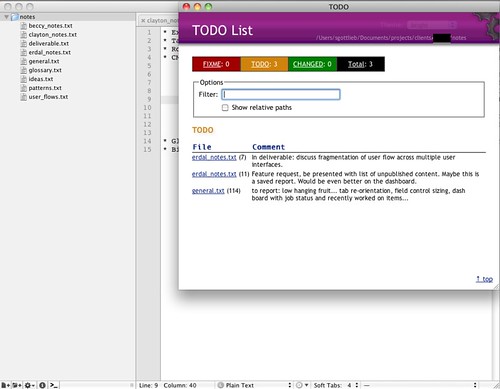Jul 08, 2014
I learned something new about IE9 today. Apparently, when visiting a site in the same domain as the computer, IE9 defaults to compatibility (quirks) mode. I am guessing that this is Microsoft trying to accommodate crappy intranet sites (cough cough SHAREPOINT cough cough).
So, if your site depends on standards mode, you might find that it looks fine in the real world but not in the office. I work remotely and this has burned me twice. Both times my launch celebration was cut short by complaints from colleagues in the office who saw broken pages.
Now I know.... And you do too.
Hat tip to Marjoe Bacus for letting me know about this "feature".
Jan 18, 2011
I have a complicated relationship with personal information management (PIM) tools. I love PIM software and services that promise to remember everything that I once knew. I am tempted by every new information gadget that comes down the pike. But I have also been burned lots of times too. I spent hours on corporate intranets documenting my knowledge only to have them shut down. I used proprietary software like the The Brain which became inaccessible when I switched computing platforms (note: now The Brain supports Linux and Mac OSX as well as Windows). My Google notebooks are now barely supported by Google. And now we have news of Delicious's uncertain future.
Because of these experiences, I have been fighting my urges to use services like Evernote, SpringPad, Yojimbo, etc.. Instead, I have been sticking with humble text files. In an earlier post, I described how I am using TextMate as a blogging tool. I have started to use it as a knowledge management tool as well.

I don't pretend that I have the features that products like Evernote do, but here is what I can do:
-
Create notebooks with multiple pages by using TextMate's project feature.
-
Organize pages into folders.
-
Create todo items and other tags that I can summarize by using the ToDo bundle
-
Search using "Find in Project" or Spotlight.
-
Collaborate with others using GitHub or another code hosting service.
-
Store and organize binary files like diagrams created in OmniGraffle.
The truth for me is that the greatest benefit of any PIM tool is simply the act of recording and organizing the information. These activities help me remember and process information into actionable knowledge in my head. You can do that with any tool. The second most important aspect is search and recall. This is where the open format of text files really excels. It would be really frustrating to try to retrieve some information but not have access to the software to consume it.
Jul 28, 2010
I JUST heard about Adobe's acquisition of Day Software and have to admit my first reaction was total disappointment. I always admired Day's commitment to architecture and standards. Day is one of the few upper upper tier web content management companies to stay focused on the web — not just as a place to dump files but as medium for information exchange and creativity. David Nuescheler and Roy Fielding seemed to have a vision for how systems could openly interoperate through lightweight architectures like REST and standards like the JCR. Day has also been a great contributor to the Java community by pushing lighter weight technologies like OSGi and server-side JavaScript to keep Java relevant in a trend toward dynamically typed, scripting languages like PHP, Python, and Ruby. Day promoted this vision through the products they sold and also by contributing to open source projects.
I feel the complete opposite about Adobe. Adobe seems more interested in conquering the web than improving it. While Adobe has contributed several technologies that lowered barriers to entry, I think the overall net impact has been negative. Yes we have more content on the web thanks to Adobe, but much of that content is locked in Adobe's PDF and Flash formats where it is less accessible (and maintainable) than plain old DHTML. Adobe customers tend to overuse Adobe technologies like PDF for online forms when HTML would have done quite well. Flash-based navigation is also a problem; I can't tell you how many restaurant websites I have been where you can't link to a specific page because the whole site is one Flash movie. As a web consumer, how many hours have I waited for Acrobat reader to install/upgrade plugins (which further degrade performance) before allowing me to read PDFs that I clicked on? Expert tip: disable the PDFViewer plugin for Safari. Don't even get me started on DreadWeaver.
As you can see, my frustration with Adobe has been building for quite some time. It felt good to let that out. I haven't talked to David or Roy about Adobe so I don't know their opinion of Adobe before or after the merger talks started. I hope that Adobe permits them (even better, supports them) to continue their good work in web-based architectures. More likely Adobe is buying Day for its CRX repository and CQ5's workflow and digital asset management (DAM) functionality to connect creative teams using Adobe Creative Suite (Why couldn't they have just bought vjoon or WoodWing?) If this is the case, I hope Adobe will invest more in web publishing than they did JRun.
